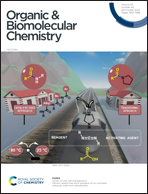Recent developments in the synthesis of the isoquinoline-1,3(2H,4H)-dione by radical cascade reaction
Abstract
In recent years, isoquinoline-1,3(2H,4H)-dione compounds have attracted extensive attention from synthetic chemists, with the aim of finding simple, mild, green and efficient synthetic methods. In this review, we summarize the diverse range of synthetic methods employing acryloyl benzamides as key substrates to furnish isoquinoline-1,3-diones using different radical precursors, such as those containing carbon, sulphur, phosphorus, nitrogen, silicon and bromine. This will stimulate the interest of readers to engage in research in this field.



 Please wait while we load your content...
Please wait while we load your content...